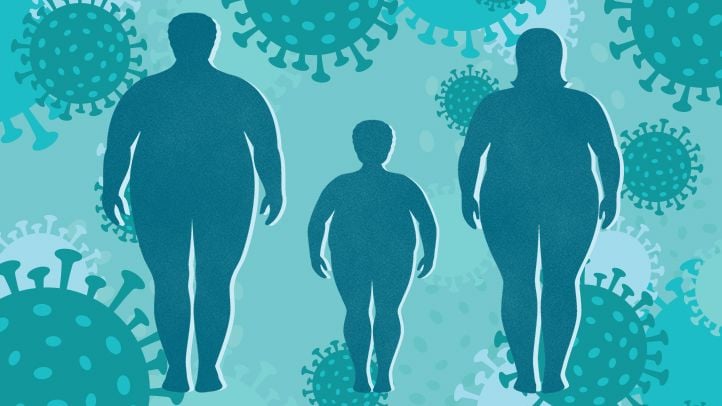The coronavirus pandemic has spotlighted another crisis that threatens the health of over 107 million American adults: obesity.
The global obesity pandemic, which began long before the recent coronavirus one, continues to grow today, with over 42% of Americans classified as obese. Overwhelming evidence shows that obesity increases susceptibility to the virus and the risk of severe illness from COVID-19.
In July, The Center for Disease Control revised its risk categories for COVID-19, placing obesity next to conditions including heart failure or chronic lung disease as increasing the risk of severe coronavirus illness. Additionally, scientists lowered the bar for where that risk starts to patients with a Body Mass Index (BMI) of 30 or higher, greatly expanding the population thought to be most vulnerable to the virus.
“The additional weight increases abdominal pressure that can cause [patients with obesity] to have reduced lung capacity, and be more prone to diminished airway flow,” said Marwa Abu El Haija, clinical assistant professor of pediatric gastroenterology at the Stanford School of Medicine. She added that this demographic also has a higher risk of asthma and a harder time clearing infections from their lungs.
Other mechanistic factors — for instance, patients with obesity need larger bariatric hospital beds — complicate treating infections.
“These patients have a more challenging intubation procedure to hook them to a ventilator if they have respiratory failure. It is also more difficult to obtain optimal imaging because of certain weight limits on CT scanners and MRI machines,” Abu El Haija said.
On the molecular level, obesity is known to interfere with the immune response. While a healthy immune system can call on immune cells and signal proteins when appropriate, patients with obesity often experience a state of chronic inflammation — an immune response that can no longer be turned on or off as needed.
Excess fat in the stomach and the organs can trigger the release of cytokines, markers for inflammation that circulate in the body, and hormones such as leptin, that are believed to induce this chronic inflammation.
“Patients who have COVID have an immune complication called ‘cytokine storm,’ which increases the rate of cytokines circulating in the body,” said Abu El Haija. “One cytokine, IL-6 or interleukin-6, is actually highly pathogenic in SARS-CoV-2 infections — meaning it’s increasingly replicated, mainly in the lower respiratory tract and the lungs.”
Not only do patients with obesity have a harder time clearing infections in the lungs, they also, at a baseline, have higher levels of interleukin-6 because many are in this state of chronic inflammation. Abu El Haiji points to recent study that found many coronavirus patients who did not survive had much higher levels of interleukin-6. In other words, she said, higher levels of interleukin-6 translated to lower COVID-19 survival rates.
Most strikingly, studies show that obesity and the coronavirus directly share certain molecular pathways, significantly increasing the likelihood of COVID-19 infection.
“Excess fat expresses angiotensin-converting enzyme, or (ACE) 2 protein, and the SARS-CoV-2 virus seems to enter cells through the ACE 2 receptor,” said Abu El Haija. She says that ACE 2 receptors provide docking sites for infiltration and replication of the virus, putting patients with obesity at increased risk.
In discussion of the intersections of obesity and COVID-19, Abu El Haija points out the importance of a “patient-first language” when referencing patients with the condition.
“We should mention the person first and then give the diagnosis, so we don’t describe them only by their diagnosis, she said. “We would say this is a 17-year-old male with obesity, not an obese male. A lot of times we forget that rule when it comes to obesity and people just starting defining patients by their condition.”
While fighting the coronavirus pandemic is at the forefront of the scientific agenda, some doctors say it has underscored the need to find solutions to America’s obesity pandemic with the same rigor. Christopher Gardner, professor at Stanford Prevention Research Center, adds that focusing on a healthy diet and maintaining an active lifestyle during this time is an important way people with obesity can protect themselves from the coronavirus.
“There are five foundational principles of diet everybody [in the nutrition community] seems to agree on either: eat as many vegetables as you can, eat more whole foods, and try to eliminate processed foods, added sugar and refined grains,” Gardner said. He identified the toxic food culture that normalizes cheap, constant consumption in America as the main culprit.
“It’s this acceptability of eating in the car, and eating out everywhere 24/7. The food industry has made sugar, salt and fat all delicious,” Gardner said. He said that during the current quarantine period, people are eating healthier, home-cooked meals in lieu of eating out. The COVID-19 pandemic has also decreased the availability of healthy foods, though, contributing to a higher incidence of obesity in America.
Gardner adds that there has been a spike in binge eating, which makes it difficult for individuals to maintain a healthy diet that will protect their bodies from disease.
“With so much going on,” he says, “a healthy diet is the least of their concerns.”
Contact Rachel Kavalakatt at rkavalakatt ‘at’ gmail.com.
